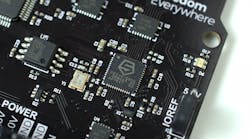Before he agreed to anything, Naveed Sherwani needed to make 40 phone calls. He had questions about the new RISC-V computer architecture and the company founded by its inventors, SiFive. He had been asked to run it.
Sherwani, a founder of Open Silicon, called venture capitalists and semiconductor executives, who agreed unanimously that the free and open architecture had serious potential. “I was expecting half the people to tell me, ‘I don’t know, it’s kind of a new experiment.’ That’s typical when you are starting a new venture,” he said in an interview.
In July, Sherwani started as chief executive of SiFive, which announced the hiring last month. SiFive is using the RISC-V architecture in an attempt to make custom chips more affordable and to eliminate common annoyances with licensing other architectures like ARM and MIPS.
Asked what he hopes to accomplish in his first six months, Sherwani’s answer is unsurprising. He wants to rapidly grow the business, which has raised $13.5 million since being founded in 2016. His checklist includes hiring engineers, investing in software development, and improving SiFive’s turnaround on custom chip orders.
The company has already “made the front-end part of the design extremely efficient,” Sherwani said. “We are now working on the back-end process – the verification process – to create what we would call a chip design factory, which would allow people to do custom silicon extremely fast.”
SiFive plans to make money by providing customization and support around RISC-V, making it simple to commission custom chips for a multitude of applications. That includes the Internet of Things, which could require lots of small batches of silicon that will never sell enough to warrant the same amount of money poured into smartphone and personal computer chips.
SiFive also wants to act like a clearinghouse for intellectual property. The company charges a one-time payment less than a million dollars to license its unique cores for data center and Internet of Things applications. Last week, it introduced a program called DesignShare to provide blueprints from companies – like Rambus – at lower cost or for free.
Sherwani’s background seems like a natural fit for SiFive’s multiple personalities. In 1993, he literally wrote the book on physical design automation, which he spun into a start-up called Intel Microelectronics in 1999. He later founded Open Silicon, which acts like a contractor for custom ASICs, and ran it until 2013. He has been involved with the development of more than 300 chips.
Going forward, SiFive will need to find a way to translate the enthusiasm for RISC-V into paying customers. The RISC-V Foundation, which maintains the instruction set, includes members like Google, Microsoft, Oracle, and IBM. Microsemi has signed on SiFive’s first major customer.
Sherwani has been pleasantly surprised since taking the helm from SiFive’s founding chief executive Stephen Dyckerhoff, who still holds a board seat. “We have heavy customer demand right now,” he said. “We have three or four meetings with big corporations every day and none of them are set up by us.”
SiFive – founded by Krste Asanovic, Yunsup Lee, and Andrew Waterman – is moving in a positive direction, he said. The company has hired a human resources director to manage its growing staff, which includes former engineers from Intel and Arm. It also recently moved into a new office in San Mateo, Calif.
When asked why he thought SiFive would succeed, Sherwani said that the company can feed off the open-source software model, which was not as widespread when other open-source architectures like OpenSPARC came out. SiFive likens itself to Red Hat Software, which has built an entire business based on the Linux operating system.
“When those [earlier] hardware movements happened, open-source software had not established itself as a dominate force in the world,” Sherwani said, adding that software start-ups can grow rapidly today with maybe a tenth of custom code. “Now that the model has been set, hardware can follow it.”

